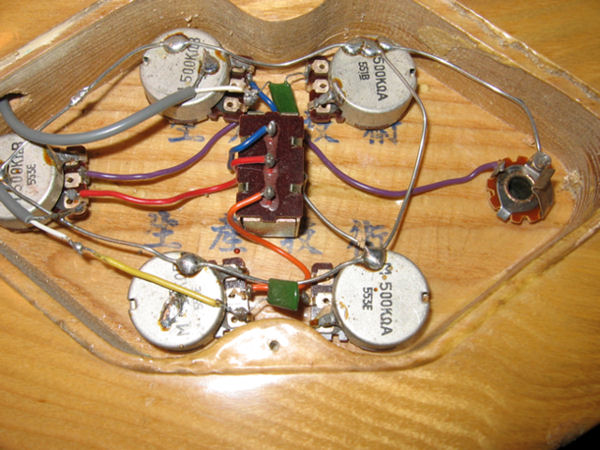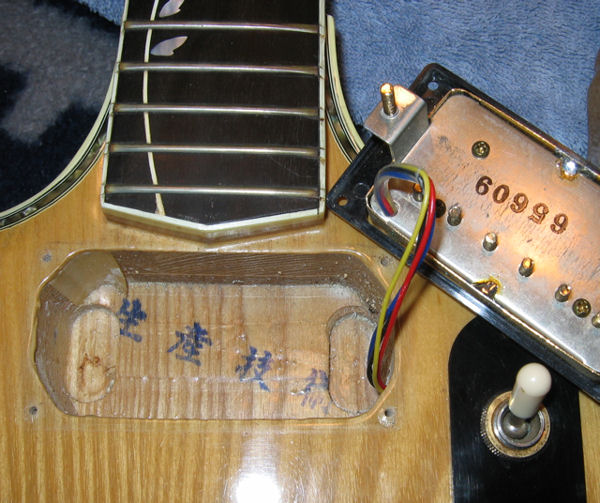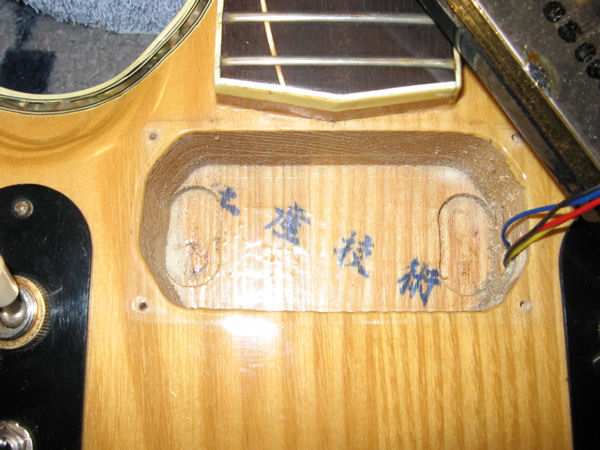|
| Author |
Message |
    
Hasenobu
Username: Hasenobu
Registered: 1-2006
| | Posted on Monday, December 10, 2007 - 7:18 am: | |
Hi, there. It's been a long time since my job kept me away from here.
Well, I'm writing this hoping to get any kind of information on a guitar I came across a week ago.
For some photos, please visit the URL below:
http://www.geocities.jp/ar_lovers_room/ourARs/O_RO UGE1984AR300PWS.html
As you can see, this one was made in Dec. of 1984, though it has some features characteristic to 1985 model.
What I want to emphasize here is that it has Lo-Z PUs as its original parts, accordingly, without tri-sound functions.
And my question is: has anyone of you seen this kind of (seemingly) AR300?
From what I heard from its owener in person, he placed an order for "AR in PW finish" in late 1984 from a local guitar shop in Hiroshima, Japan, and early in the following year, this one came to him, when he was told by a shop clerk that the guitar had been displayed in the President room (of, maybe HOSHINO).
Anyway, if you have any clues or information as to the whereabouts of this guitar, will you please let me know?
Thanks in advance. |
    
Ekkerman
Username: Ekkerman
Registered: 7-2004
| | Posted on Tuesday, December 11, 2007 - 2:06 am: | |
its a great guitar !!!
i am more in favour of golden pups myself !
still its a beauty...... |
    
Chucke99
Username: Chucke99
Registered: 2-2007
| | Posted on Tuesday, December 11, 2007 - 9:53 am: | |
Hasenobu, do you read Japanese? There is some writing in the cavities of my Artwood that I'd like to get translated. My guess is that the characters say something like "12-string" and "6 string", since the characters are duplicated in the pickup and control cavities:



Thanks for any help!
-Chuck |
    
Davehowardcustom
Username: Davehowardcustom
Registered: 10-2005
| | Posted on Tuesday, December 11, 2007 - 12:01 pm: | |
Yeah, I have one of them in the neck pickup cavity of my DT500CS. Any help there?
 |
    
Chucke99
Username: Chucke99
Registered: 2-2007
| | Posted on Tuesday, December 11, 2007 - 1:20 pm: | |
Now that I see all three photos together, it looks like the four characters are identical in each pup cavity, and are repeated twice in the control cavity. Still, it would be cool to know what they stand for. |
    
Hasenobu
Username: Hasenobu
Registered: 1-2006
| | Posted on Tuesday, December 11, 2007 - 5:50 pm: | |
Thank you for the question, Chchke99.
I'm Japanese, so I read the Japanese language.
The four letters, to be more accurate, Chinese characters, stand for "production technique."
The first two letters mean "production," and the latter "skills/techniques."
I've never known there is such writing in the cavities of Ibanez guitars, and it seems to be a kind of mystery to me.
Seeing your photos, I guess that the people in the factory back then imprinted the characters as a reminder of, or a testament to their mottos. |
    
Chucke99
Username: Chucke99
Registered: 2-2007
| | Posted on Tuesday, December 11, 2007 - 7:26 pm: | |
Chinese characters? Wow. Is that common in Japan, to use Chinese characters like that? Not just in guitars, mind you, but as mottos? That's a very cool finding, indeed. Thank you for the translation!
Could there have been Chinese craftsmen involved in the creation of this guitar at the Fujigen factory?
-Chuck |
    
Gemberbier
Username: Gemberbier
Registered: 5-2006
| | Posted on Tuesday, December 11, 2007 - 8:27 pm: | |
What I know, is that the Artwood 2408-1,2 and 3 (Dragon, Sequoia and Eagle) got their carved tops from Taiwan (Formosa). So, probably your guitar was actually made in Taiwan. Nothing bad about that. Yamaha's top jazz guitar was made there too, when production in Japan got too expensive.
Just let the serial numbers speak, (if available).
That goes also for your DT500CS, Dave.
Ginger |
    
Johns
Username: Johns
Registered: 2-2001
| | Posted on Tuesday, December 11, 2007 - 10:59 pm: | |
Chuck:
Last week my Japanese buddy was explaining how complicated Japanese is (his wife is trying to learning it). In doesn't help matters that there is a lot of Chinese thrown in. So, the presence of these characters doesn't surprise me. |
    
Chucke99
Username: Chucke99
Registered: 2-2007
| | Posted on Tuesday, December 11, 2007 - 11:47 pm: | |
That's my Artwood Twin, Ginger, no serial number, circa 1975 or so. I guess the body could have been started in Taiwan, but I don't think so. |
    
Emilio
Username: Emilio
Registered: 9-2004
| | Posted on Wednesday, December 12, 2007 - 4:31 am: | |
Wow Chuck! So we can be sure now that youre Artwood Twin is a cheap Chineese copy
cheers
emilio
I'll have a look on mine |
    
Michaelkaufman
Username: Michaelkaufman
Registered: 11-2002
| | Posted on Wednesday, December 12, 2007 - 8:27 am: | |
Poor Chuck 
You should sucker someone else asap ...
mk |
    
Hasenobu
Username: Hasenobu
Registered: 1-2006
| | Posted on Wednesday, December 12, 2007 - 9:43 am: | |
Hello.
Chuck, to your question "Is that common in Japan, to use Chinese characters like that?," my answer is yes and no. At least, my feeling is that it's very strange to imprint Chinese characters in the cavity of a guitar. And in this sense, I wrote "a kind of mystery to me."
But if what Gemberbier has written is true (not that I doubt his information), then it is most plausible.
And as to your second question "Could there have been Chinese craftsmen involved in the creation of this guitar at the Fujigen factory?," I would like to answer "No" though I'm not 100% sure in saying this. I've read an autobiography of Mr. Yokouchi (former president of Fujigen), but there's no description that they had Chinese craftsmen back in 70's in thier factory in Matsumoto, Japan.
Anyways, isn't there any information about the guitar with which I started this thread?? |
|
|
Thank you for supporting Ibanez Collectors Forum. Please help your favorite Ibanez guitar site as we endeavor to bring you the latest information about Ibanez custom vintage electric and acoustic guitars. Here you can discuss ibanez, guitars, basses, acoustics, acoustic, mandolins, electric guitar, electric bass, amplifiers, effect pedals, tuners, picks, pickups.
|






